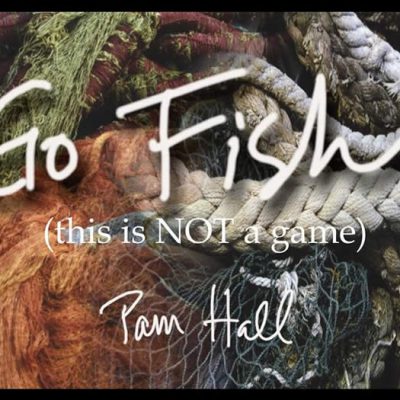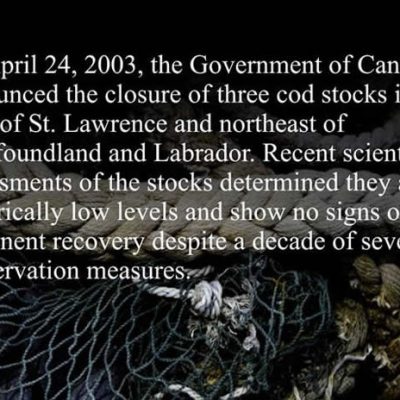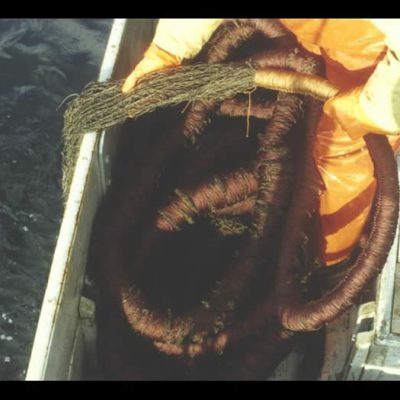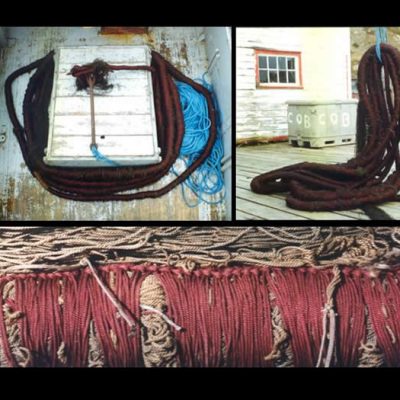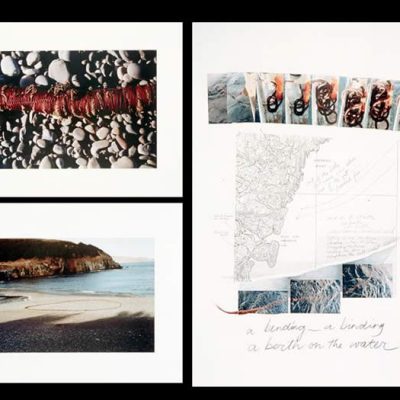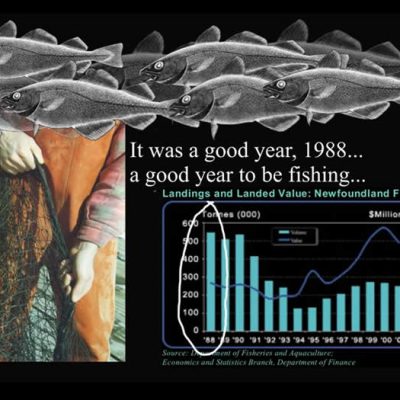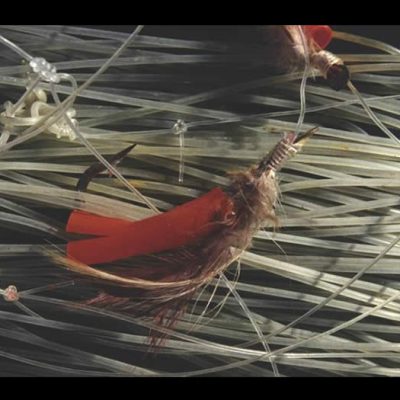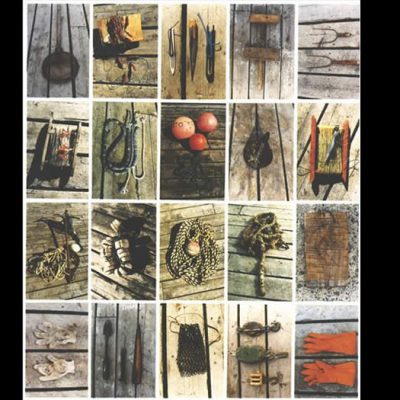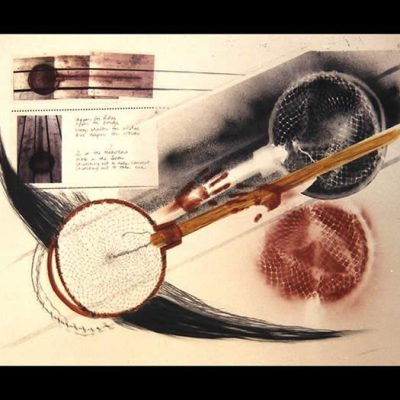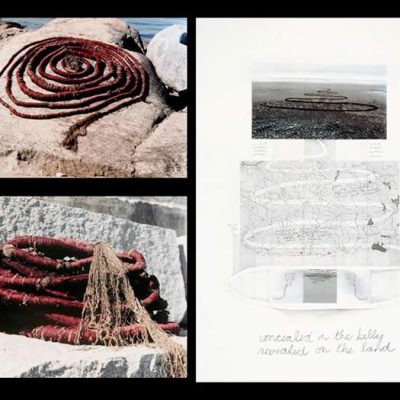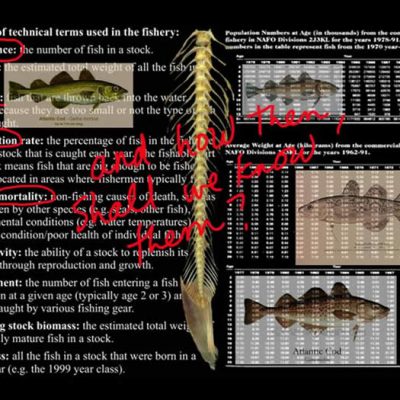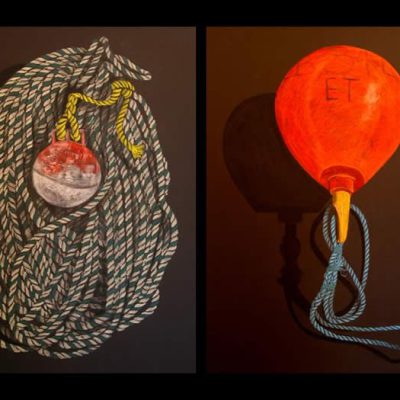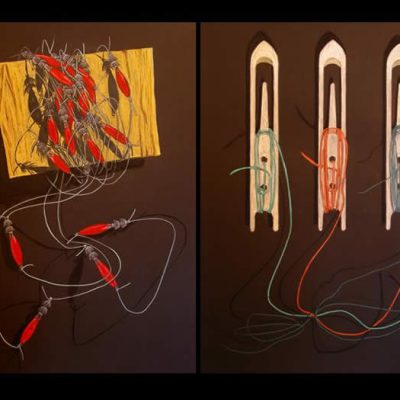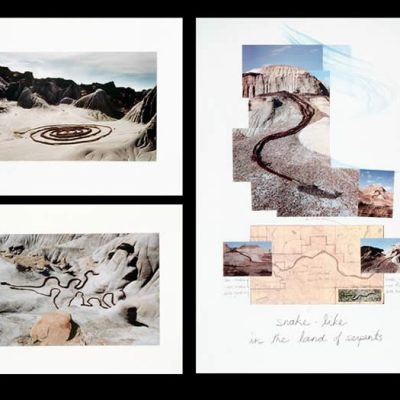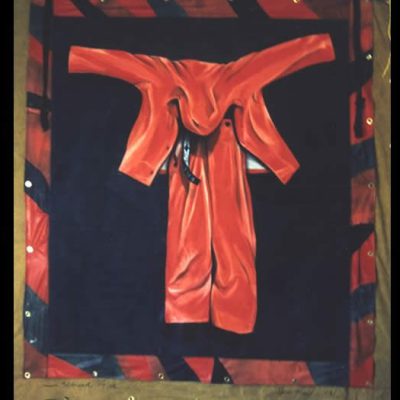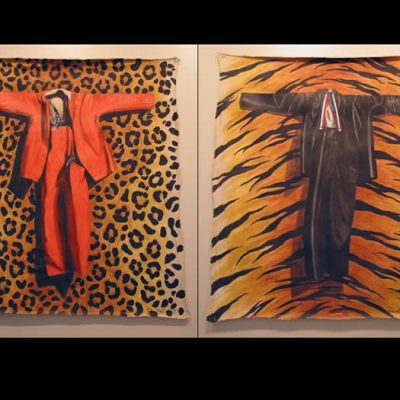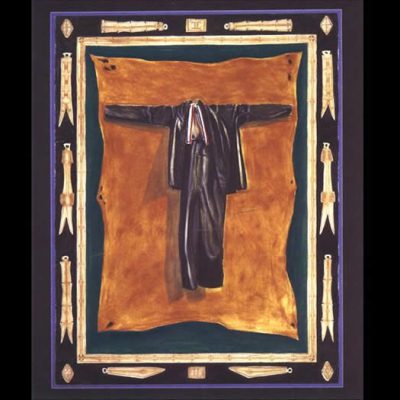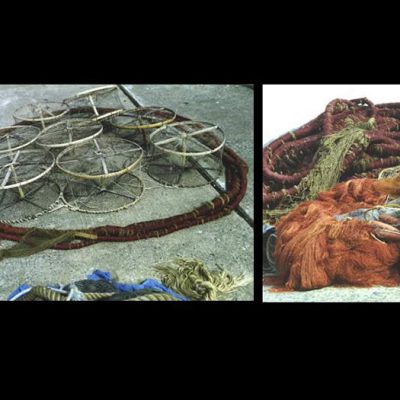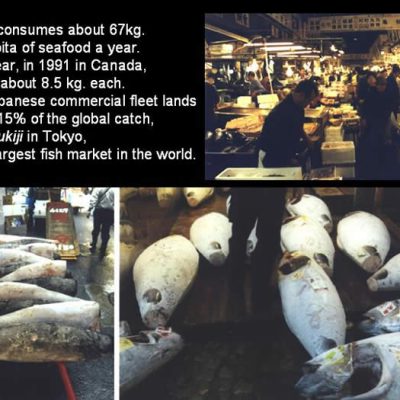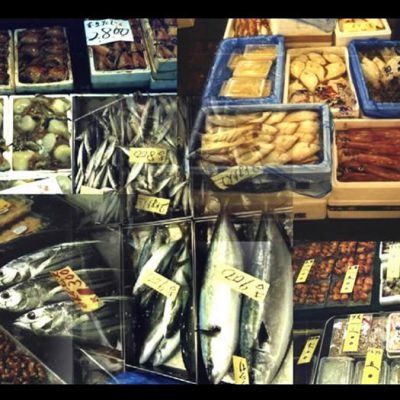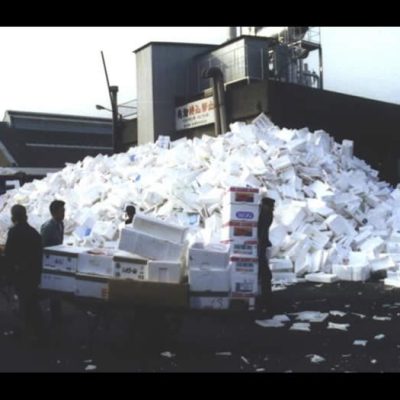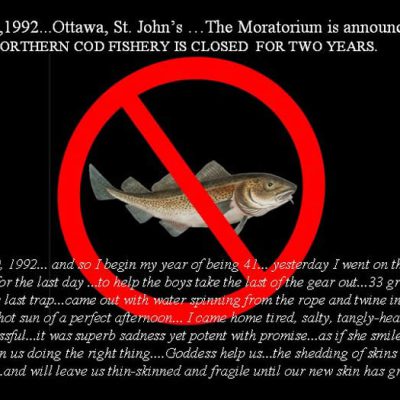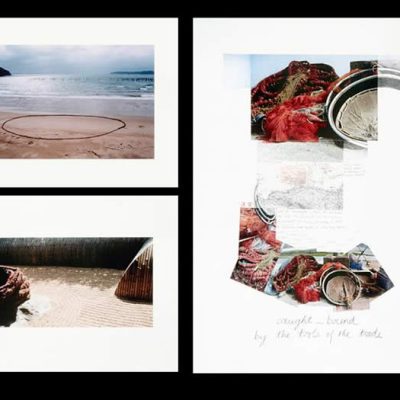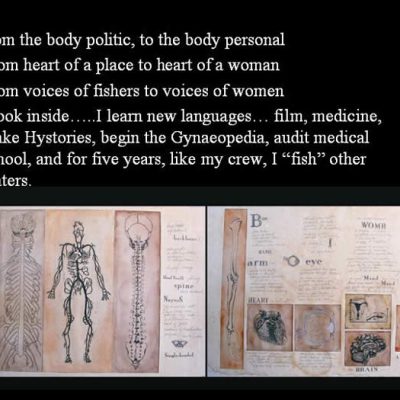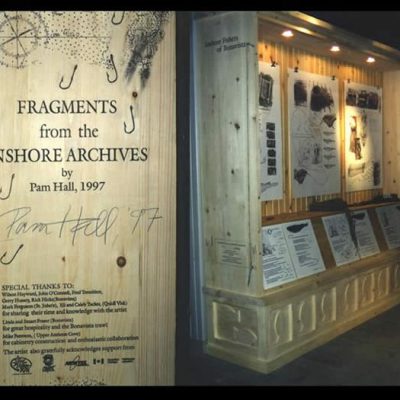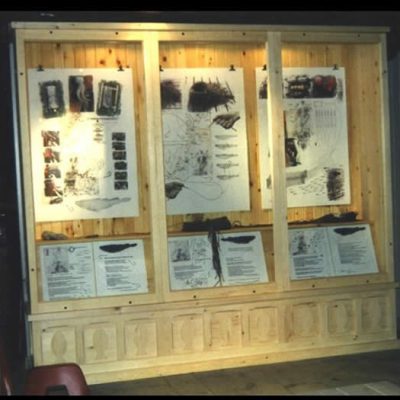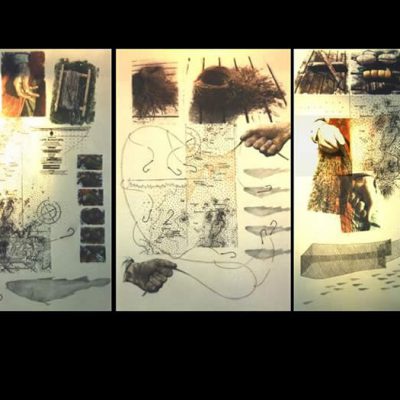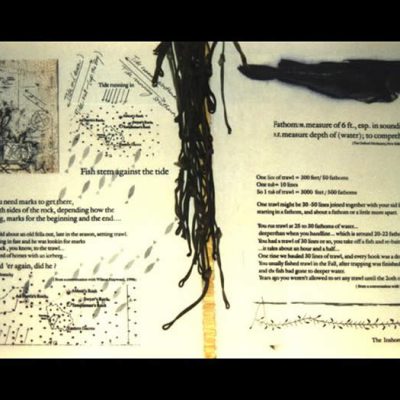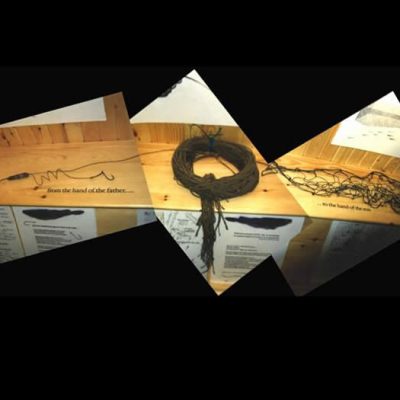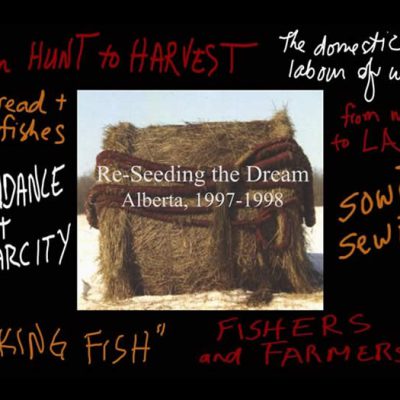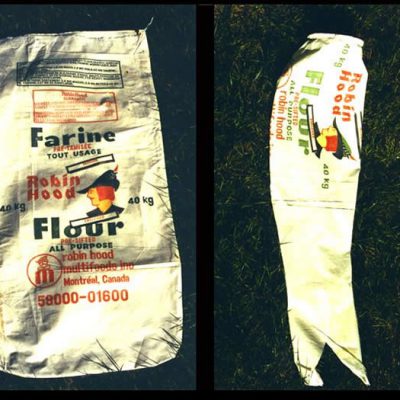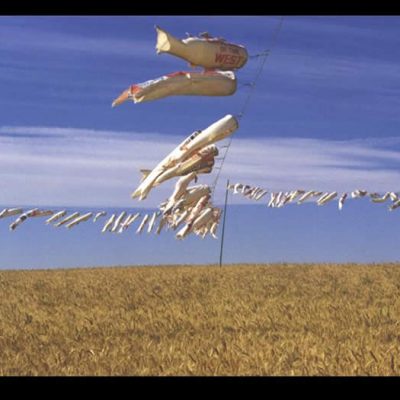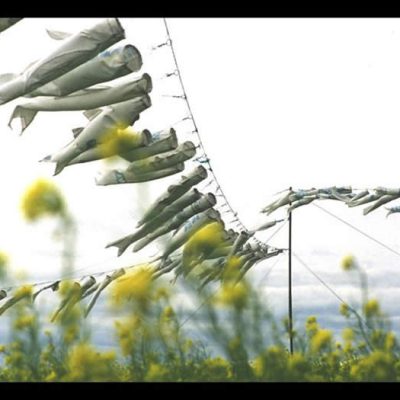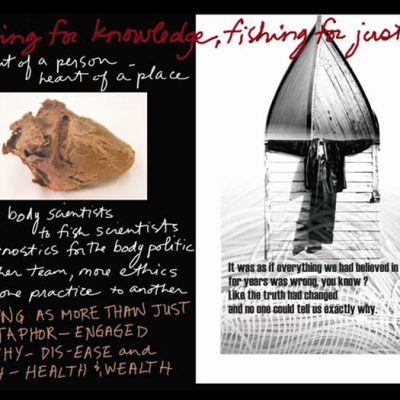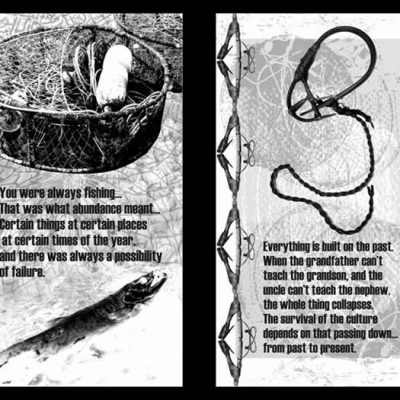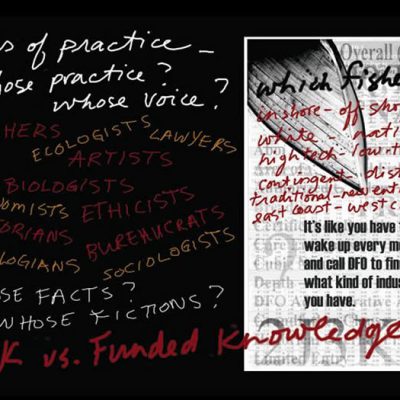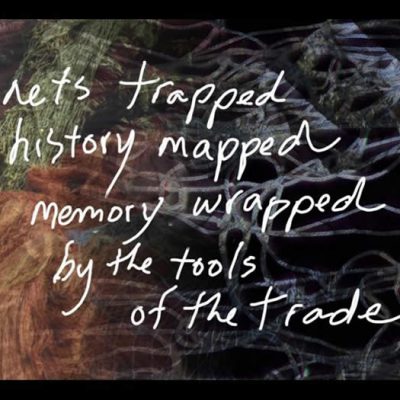Go Fish
This performative lecture was first delivered in 2003, within a graduate residency exploring the theme of Abundance, at Goddard College in Vermont. What follows are excerpts only – the full talk ran over 60 minutes with almost 80 images/slides. Using over 15 years of Hall’s creative work addressing the subject of the fishery, Go Fish was part artist’s talk, part storytelling, part history, part politics. Primarily intended to create dialogue around both art and the environment, it opened a terrain of discussion ranging from eco-art to social justice, from ethics to community engagement.
Click the thumbnails below to view the slideshow with captions.
- When I was a child we played a card game called Go Fish… the object was to get ALL the cards of a certain type… all the fives, or all the Jacks or all the Kings. Then you would lay them down, and move on to another kind of card. Whoever had the most kinds at the end would win… but you had to play until all the cards were gone.
- We are now well into the game.
- I remember that first wharf that first day I walked onto it… It was Eli Tucker’s wharf… a trap skiff skipper with five sons… two of whom still fished with him on a 5-6-man trap crew. Caleb, the youngest son, would become a playmate, an ally, friend, a brother…I spent weeks moving around nets and gear and twine… heavy with its own history in the water, rich with its own stories… pungent with its own smell. I wanted something like that of my own… It all started something big… transformed me forever.
-
As well as going fishing late that season, to handline October cod with Caleb from deeper waters, I made The Coil, from an old codtrap Eli was going to send to the dump, and began to build her life on water and land. The first day of her life, we took her out on one of Eli’s boats and threw her into the sea…
Caleb hauled her over the gunnels as if she was a “real catch”…..
-
from boat to wharf, from barrens to beach, I laid her down- lightly on the land…
A long continuous story at the beginning of its first chapter… a process to mark a practice… one long labour to honour another…
I don’t know how many cod traps were “at work” in Newfoundland that season… but their were almost 30,000 licensed fishers that year, and almost 10,000 had groundfish licenses, which means they were fishing cod.
- Bound by my hand, laid on the land, bound by the seasons… til the weather closed in, and her echoes both followed and led me into the studio to begin telling her story in what language I had then as an artist.
- It was a good year, 1988….to be fishing… for protein…for meaning… for experience of this new world. The same “New World” to which John Cabot had come in 1497 looking for a trade route to the Orient, but finding codfish so plentiful his crew could haul them aboard by simply dropping baskets into the sea.
- I was hooked. By the work of it… by the knowledge of it… by the humility of it… to throw a single line into miles of black water and trust it would find fish…
-
I was hooked on the gear of it… the small tools which extended the human body into such an environment… made the reach longer, the grasp firmer, transformed the long line into twine nets, allowed a man or a half dozen men to haul ten fish, or ten thousand lbs. from the inshore waters of Torbay, Bonavista Bay or Conception Bay
The floats and grapnels… the killicks and buoys, the puddins and balloons, to weight down, to hold up.
the jiggers for squid, the jiggers for cod the trawls, the traps…
- made for the hand… unmechanized… low technology…simple
- and echoing the form and function of fishing tools of coastal tribes across the world and spanning centuries. Artifacts… Inshore artifacts… for me then, as potent with mystery and intrigue as anything I had seen in the museums of the world.
- and so I explored and figured and wondered and made… winter’s work… me busy in my studio, my crew busy in the twine loft… preparing for the new season to arrive…
-
and arrive it did… in Newfoundland I fished codtraps…
on Vancouver Island, I worked another season with The Coil… new learning spinning out of practice like water off twine coming over the gunnels of The Big Diesel…
-
and new questions rising… there were fish, there were fishers, there were boats, there were stories, there was data…
there was history stretching back forever … and future stretching forward…
or so it seemed then.
-
and still there were those objects… those tools of the trade.
so potent and storied… just as “beautiful” to me as a Dorset spearhead, Or Beothuk pendant…
-
I wanted to “know” them… to give them my time….
to honour them the way we honour history… a Haida Halibut hook, or an Inuit twine needle…
It was like working with the history of something not yet past… not looking back with reverence… but looking around-
and paying real attention.
And in the looking around, another season passed…
-
And in the spring- the Coil called me back onto the land, and the fishery back onto the water.
This time she took me to the Alberta Badlands… water-shaped, an ancient sea-bed with fossils of sea life and dinosaurs bones in the ground.
And home… we stopped putting out salmon nets, and fished 6 or eight trap berths for cod.
-
By now it was 1991 and trouble was brewing… all this time, and for years before, the offshore fleets, first foreign and then domestic, had been scooping up fish… the cod landings had dropped from over 300,000 metric tones in the early 80’s to just over half that (178,687 metric tonnes) in 1991. Inshore fishers were worried, but still fishing, and everyone was using the phrase “ too many fishers chasing too few fish”.
They were worried about their future… the future of the inshore stocks… worried about the draggers/trawlers, scooping up fish, sea-bottom and all.
I began to see fear and frustration, distrust and bitter competition… and saw them becoming thin-skinned under their rubber clothes… imagined the shedding of skins…
- They say that the shedding of skin is an old thing…going way back into the far times, to the first big snake at the beginning of the world…That First Serpent wore its skin like armour that could not be pierced…It was thick and old and worn from the rubbing of belly over the ground…They say that it was dark and dull in colour and crusty and dusty from all of the goings and comings of that old snake through the forests and swamps and deserts. They say that old snake shed its first skin to become more beautiful in the eyes of the First Woman. His new skin was beautiful and gleaming and deeply colored like a hundred jewells, but his new skin was soft and thin, and she pierced it with a sharp knife…so he grew his old skin back again…to protect himself from knives. Then one hot day, long after the First Woman had gone, somewhere else, they say that he shed his skin again…because he was hot in the steaming sun. But the sun burned his soft new skin ,and so he grew the old one back again, to protect himself from burning.
-
Then, on another day, long after, he shed his skin a third time, so he could feel the breeze that was blowing, and the gentle mist that was falling from the sky. But the breeze became a big wind, and the mist turned into hard rain, and he grew his old skin back again to protect himself from bad weather. They say that each time he shed his skin, he learned something, and because he could grow it back, he kept doing it. It became a habit…and all the ancestors of that snake keep it up to this day
They say that we humans learned a lot from that first snake at the beginning of the world.They say that we humans learned to grow thick skins to protect ourselves from the big winds and the hard rains…to protect ourselves from the burning sun…and to protect ourselves from knives. They say that for we humans, it also might have become a habit, except that humans didn’t have the courage or the curiousity of the snake. And so when we shed our skin, in those far days at the beginning of the world, they say that the pain of everything on the new, thin, skin was too much to bear.
-
So, they say that we humans stopped shedding, like the snake, and now we have a hard time learning, because our skins are too thick, and our fear is too great. But that’s only what they say…and it may not be the one true story. There are other stories about the shedding of skins…any one of them might true…
and I suddenly saw… or perhaps finally imagined, how exotic they were… these inshore men… like the last of a kind…exotic, endangered, extinct….?
Like the Beothuks before them. Following in the footsteps of their ancestors… moving or being moved towards oblivion, it was worrisome and contentious and scary…
but they kept fishing…
-
as did I…
on the water at home only a little…
and taking The Coil to Japan… to a nation of fish-eaters…
- “Tsukiji is a fish market in the sense that the Grand Canyon is a ditch or Caruso was a crooner. Among the wholesale fish markets of the world, Tsukiji ranks at the top in every measurable category. It handles more than 400 different types of seafood, from penny-per-piece sardines to golden brown dried sea slug caviar, a bargain at [U.S.] $473 a pound. It imports from 60 countries on six continents. Tsukiji moves about five million pounds [2,268,000 kilograms] of seafood every day—seven times as much as Paris’s Rungis, the world’s second largest wholesale market, and 11 times the volume of New York City’s Fulton Fish Market, the largest fish market in North America. In dollar terms, that comes to [U.S.] 28 million dollars’ worth of fish. Per day.” —From National Geographic, 1995
- I was overwhelmed by the “abundance”…
-
or was it by the scarcity revealed in such abundance….?
I came home in my heart to the political realities of the tip of the iceberg I had been dancing on since 1988.
-
and home physically , back to Canada, to political realities in a very real way. In 1992… the cod landings in Newfoundland and the Gulf were down to 75,000 metric tones… from the early 80’s to the early 90’s… in a single decade, they had dropped from over 300K to 75K. I still don’t know the numbers on what percentage of the landings in those years went to inshore fishers as compared to the large, high tech, offshore fleet, but between 1964 and 1977, the foreign offshore fleet took 5.192 million metric tonnes compared to the inshore fleet’s 1.1 million. (that is only 17.6% of the entire landings of cod in that period, that went to inshore fishermen.)
the day after the moratorium was announced, I wrote…
it is a great, wrenching, act of surgery…
the sharp, but jagged cut…
almost, in spite of years of imagining it…
beyond imagination.
-
Japan was the final chapter in the life of The Coil… a creature and creation of the inshore fishery in Newfoundland, it seemed wrong somehow, that she should be “working” when all the other codtraps had been brought ashore for the final time.
Nets to entangle- tools to ensnare
One role to nourish- one to impair
To harvest to feed- to ravage-to bleed
To consume and deplete or renew and repair
Indeed… we had all been Caught and Bound, by the tools of the trade….
-
And so I turned… turned away… was turned… become a hangashore….
In my journal I wrote…“ Cod is over in the inshore… finished… crab is rising but how can I be on the water when Caleb and the boys hunt shellfish in the deep water…miles from home, gone for days…fishing down the food chain….
Caleb hates it… though thinks it better than fishing shrimp on a factory freezer trawler, like his brother Wayne”.
Caleb knew in ’92 what fisheries scientist Daniel Pauly, wrote in 1998, “Cod feed on shrimp. If you remove the shrimp, then how will the cod recover?”
-
But in 1997, I turned back. In 1497, when John Cabot made landfall at Bonavista, Newfoundland, it marked the beginning of the 500 year old North Atlantic cod fishery, (not to mention colonialism in Newfoundland, perhaps in North America) and like all governments in search of the tourist dollar, ours decided to have an anniversary celebration of gargantuan scale… and one which, thankfully included the artistic community of the Province. Long story short, they called for proposals…looking mostly for historical pageants I think, and perhaps some marketable posters of The Matthew, Cabot’s ship…. here is an excerpt from mine… written in 1996-
“Fragments from the Inshore Archives, intends to add the “voice” of the artist and of inshore fishers themselves, to the others which will “tell the tale” of the fisheries in Bonavista in 1997.”
- “The manner in which we, as Canadians and Newfoundlanders, identify, preserve and “interpret”, our cultural and historic resources, has for many years been one drawn from a European heritage of the museum as a centre for study, as a site for the collection, examination, elaboration and exchange of knowledge. We are accustomed to our museums telling us a kind of truth…assigning value to the knowledge within its walls. In the case of Bonavista, this assignment of value, this examination of one’s immediate “place”, site, or environment, represents an important and overdue allocation of worth to the “local”, yet renders “worth-less” all those whose perceptions which might remain outside the “walls”.
-
I wanted to put something inside those walls that spoke the voice of practice… practicing fishers, with generations of knowledge… knowledge that had been left out of the scientific data, the environmental data… and had been reduced to folklore…to anecdote…to something more akin to myth than to reality.
I knew there was real knowledge there…had seen it… in the bodies and minds which used the handline… laid the trawl on the ocean floor… set the cod trap…
-
knowledge about knowing your marks, understanding where you are on the water, knowing the wild fish…seeing into the water…
“you got to know where to handline to…you could sit all day and never get a fish… there’s what they call the nest… on every rock… fish always swims towards the tide, so you got to have the marks for the upper part of the rock for when the tide is going down, and you got to have the marks for the lower side for when the tide is running in the bay” —John O’Connell
“first thing, you know the way the tide is running… if the tide is going in the bay you’d lay trawl on one side of the rock, and if it’s going the other way, out the bay, you got to set your trawl on the other side….” —Wilson Hayward
-
and when Fred Tremblett said… “you gather a wealth of information when you’re fishin with your father…”
I asked Caleb if he thought Eli would let me cast his hand… I knew Caleb would agree, but worried that the old wolf would baulk at something so clearly from my world, after letting me into his for all those years. The day he came to the house to have his hand cast… I could smell him from the third floor… he had spruced himself up, bless his heart, and had put enough Brut on for three crews of men. But I “got him”… the hand of a real father, and the hand of his real son… circling back one upon the other…generation after generation, idea laid on idea….
- and there is, it seems, always that circling… that past embedded in the present…that leading line to follow…. That thread of meaning and connection to stretch out. So, following a thread laid out by the Coil in a farmer’s field on the island of my Mother’s birth, I went west to the wheat fields of southern Alberta… to see if the dream of abundance could be re-seeded in the “miracle of the Bread and the Fishes.”
-
In the traditional Newfoundland cod fishery, before freezing came along, the fish was salted… or “made”… and by the women, mostly.
I wanted to explore that notion of “making fish”, of female labour, and explore the connections between those old practices of the hunt and the harvest… both directly engaged with the non-human “natural” world through old knowledge and embodied labour…
I wanted to follow that path…
-
I wanted to choose materials which were “local”, specific to the domestic labour traditions of the place, and settled on something that carried its own history of re-cycled use….
and so, with the last 300 cotton flour and grain bags we could locate in Southern Alberta, I found 9 farm women who volunteered to help me “Make Fish”… sew – s-e-w… another kind of seed that I could then sow s-o-w into the land to mark the connection between fisher and farmer…
Together we worked… making something strange out of material used for making “useful things”… dish clothes, children’s pyjamas, cup towels…
we sewed and we sewed and like women working in the old salt fish industry in Newfoundland, we MADE FISH.
-
Re-Seeding the Dream, 18 miles south of Lethbridge, Alberta, on the Lanier farm, flew 149 fish over a field of winter wheat.
I had no idea how they would fly in those prairies winds…I was stunned and delighted they appeared to be swimming…across land, that 80 million years ago was covered with an inland sea.
-echoes of “cheap protein” flying over “cheap protein” , in a world that wants cheap protein and has little understanding of the labour and knowledge which produce it.
An echo of scarcity dancing in a field of abundance…
re-seeding the dream.
-
When I left those Alberta fish behind in 1997… I returned to Newfoundland and was invited to join a research team of scholars from the sciences and humanities, searching for a way to re-context the marine fisheries crisis on Canada’s east and west coasts, within a frame of ethical analysis.
For three years we worked together… bringing diverse disciplinary perspectives to the problems, building new knowledge, new discourse…
-
and all the while partnering with those engaged in the fishing industry at all levels- listening to many voices…
When the time came for me to “Write my chapter” I looked hard and long at the “voices” and perspectives present around our table, at the fine and rigorous representation from marine biology, fisheries science, the law, ecology, history, theology, sociology, economics, philosophy….
and for me there was a category of voice absent… and that was the voice of practice…the voice of fishers… and I wanted badly to put it there, beside the voices of “funded knowledge” across the disciplines… “I can DO that” I thought.
That’s worth doing.
-
So, ten years after I first walked onto Eli’s wharf… I stretched beyond the inshore fisheries of Newfoundland….undertaking new research with Haida and white fishers in the Queen Charlotte Islands in British Columbia, – in Haida Qwai- to deepen and stretch what I had learned from fishers at home.
I kept listening.
- of course, all this experience, raised all kinds of questions… revealed all kinds of connections… one circle spiralling into another… one path leading to another…. The echoes of health and dis-ease in a population whether human or marine, of illness in the body, in the body politic, in the ecosystem… of ethics in medicine and justice in public resource management… was it sustainable development or developmental sustainability? Was it fish against fisher? Fisher against fisher? There was no either-or to be found.
-
JUST FISH was published in the year 2000…. Since then there has been lots of warning that predicted the Government of Canada’s final closure of the East Coast and Gulf cod fishery this April…. Lots of warning, enough warning… Too much warning… and not just about North Atlantic cod. Daniel Pauly, in “Counting the Last Fish” , published in May’s Scientific American, writes…
“George’s Bank- the patch of relatively shallow ocean just off Nova Scotia, Canada, used to teem with fish. Writings from the 17th century record that boats were often surrounded by huge schools of cod, salmon, striped bass and sturgeon. Today it is a very different story. Trawlers trailing dredges the size of football fields have literally scraped the bottom clean, harvesting an entire eco-system-including supporting substratas such as sponges- along with the catch of the day. Farther up the water column, longlines and drift nets are snagging the last sharks, swordfish and tuna.”
-
Also in May this year, Ram Myers, published a ten year study in Nature magazine which indicates that “we have only 10% of all large fish—both open ocean species including tuna, swordfish, marlin and the large groundfish such as cod, halibut, skates and flounder—left in the sea.”
Atlantic Salmon and Atlantic Cod are now listed as endangered species in Canada… as are other species of salmon, and some sturgeon species… The 5 or 6 species of wild salmon are also on the US Species at Risk lists, but so far, there is no listing for Atlantic cod, which is still fished commercially off the New England coast. I worry about that cod stock.
In 2001, Jeremy B.C. Jackson, author of What is Natural in the Coastal Oceans wrote “There is no rational scientific basis no rational scientific basis to continue fishing of wild stocks along the Atlantic coast of North America, or in the Caribbean for the foreseeable future.”
-
Last week I went down to Eli’s wharf for the first time in more than a few years.
The paint is peeling from the buildings and the boats, and Caleb was on board The Lady Tucker, the new name they gave the Big Diesel when they built up her gunnels in ’94 so she could handle crab. He was painting out the large license registration numbers on the side of her wheelhouse. Getting her ready to sell.
I remember painting those numbers on for Eli… 12 or 13 years ago. He had said “What’s the point of having an artist around, if you can’t do something useful?”
